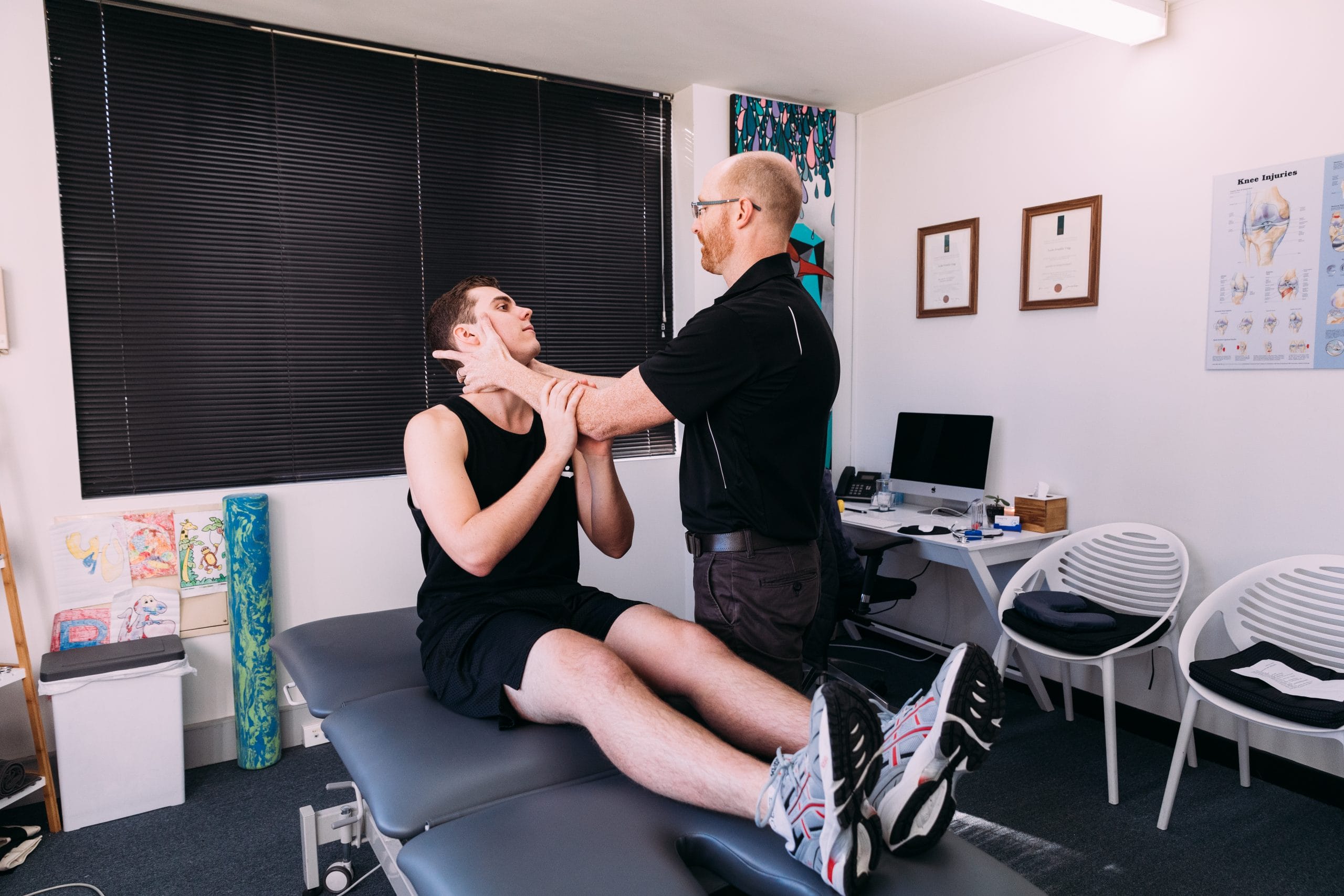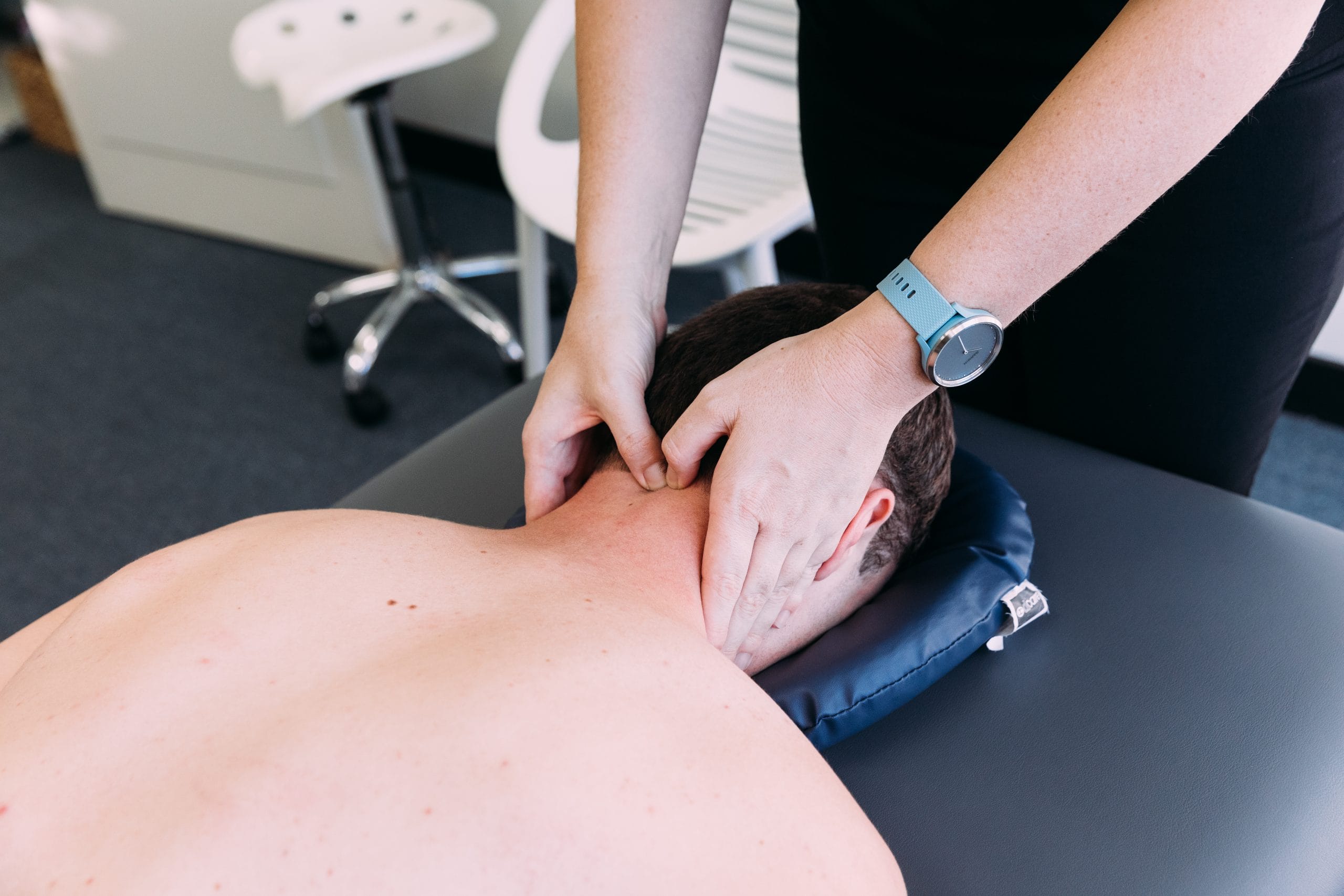
You might find yourself asking this question after a jarring car crash or a tumble on the sports field. It’s not just a term tossed around in medical dramas or insurance claims; it’s a real and often painful experience for many, involving injuries to the soft tissues in the neck area.
Whiplash is far more than a simple neck ache; it’s a complex injury that often involves neck sprains and damage to the cervical spine. This can weave a confusing web of symptoms, making it a tricky beast to tackle and understand – which is why neck pain physio is best explained by our friendly team of practitioners.
So, what exactly is whiplash, and how can you treat it?
Whiplash: the short version
Whiplash is a neck injury commonly caused by a rapid back-and-forth movement of the head, much like the cracking of a whip.
Picture this: you’re sitting at a traffic light, humming along to your music when, out of nowhere, a car bumps into you from behind. It’s not a big crash, but it’s enough to throw your head back and forth with surprising force. Those unexpected, sudden movements are the classic recipe for whiplash.
But whiplash is a chameleon of sorts. It doesn’t always show its true colours immediately. You might step out of your car feeling just fine, only to wake up the next day feeling like your neck has turned into a stiff, achy mess. Sometimes, it’s more than just pain and stiffness you’ll experience.
And it’s not just car accidents that are the culprits. Whiplash can also happen as a result of sports injury, physical abuse, or other types of trauma.
Common symptoms of whiplash
It’s crucial to be aware of the early physical signs. Whiplash symptoms can vary greatly among individuals, but typically include neck discomfort, stiffness, and a reduced range of motion. Paying attention to these early physical symptoms and seeking prompt medical advice can have a big impact on your recovery.
- Neck pain and stiffness. Often the most immediate and noticeable symptom, this is characterised by pain and difficulty in moving your neck. You’ll notice persistent pain and a decreased range of motion.
- Headaches: typically starting at the base of your skull and radiating towards your forehead.
- Dizziness: a sensation of unsteadiness or lightheadedness
- Blurred vision: temporary visual disturbances following your injury
- Fatigue: feeling unusually tired or drained, even with adequate rest
- Shoulder or upper back pain: discomfort or pain in the shoulder area or upper back
- Tingling or numbness: in the arms and hands, indicating possible nerve involvement
- Reduced range of motion in the neck: difficulty turning your head side to side or up and down
- Sleep disturbances: trouble falling or staying asleep
- Tinnitus: ringing in the ears, which may occur temporarily
- Concentration or memory problems: challenges with focusing, and issues with recalling recent events or details
Whiplash treatment
Physiotherapy treatment for whiplash
Physiotherapy plays a vital role in the recovery process from whiplash. Through a combination of exercises, manual therapy, and advice on posture and ergonomics, physiotherapists can help alleviate pain and restore normal neck function.
Initially, the primary goal for whiplash physiotherapy is to reduce your neck pain and inflammation. We can achieve this through a combination of manual therapy techniques like gentle stretching, massage, and the application of heat or cold packs.
As treatment progresses, we shift our focus towards restoring your neck’s normal range of motion and strength. Tailored exercises become a key part of treatment, aimed at gradually rebuilding your neck muscles and preventing stiffness. These exercises are designed to be low impact and are carefully monitored to avoid aggravation of your injury.
Physio treatment for whiplash is often holistic, and can include a range of other specialised techniques, like ultrasound therapy or dry needling. We want to address not only the physical symptoms, but also incorporate advice on pain management, lifestyle modifications, and stress reduction techniques to support your overall healing.

At home treatment for whiplash
Alongside professional treatment, you can also implement some at-home strategies. Make sure you consult with your doctor or physiotherapist before doing any of the following.
- Ice or heat therapy. In the first few days post-injury, applying ice to the neck can reduce swelling and pain. After the acute phase, alternating between heat and cold packs can help soothe muscle tensions and improve blood flow.
- Gentle neck exercises. Do some simple range-of-motion exercises, like turning your head slowly side to side and nodding up and down, within pain limits and after consulting your healthcare professional. These exercises can help maintain neck mobility and prevent stiffness.
- Balanced rest and activity. Rest is crucial in early recovery, but avoid prolonged inactivity to prevent increased stiffness and muscle weakening. Aim for a balance – rest when needed, but stay gently active.
- Use over-the-counter pain medication. Medications like ibuprofen and paracetamol can help ease pain. Always follow directions and consult with a doctor before starting any medication.
- Mindful practices for stress management. Engage in some deep breathing and relaxation exercises. These can not only help with your physical recovery, but also in managing any mental stress and tension associated with your whiplash.
Whiplash prevention: proactive steps
Preventing whiplash is not always possible, especially in unforeseen events like car accidents. But there are a few steps you can take to be proactive and ensure your neck is healthy.
- Proper seatbelt use. Always wear your seatbelt correctly while driving or riding in a vehicle. Ensure it’s snugly fitted across your pelvis and shoulder, not just the neck or stomach.
- Adjust your headrest. Position your cars headrest to align with the top of your head. This reduces the backward movement of your head in a collision, offering better protection against whiplash.
- Mindful driving practices. Maintain a safe distance from other vehicles to avoid sudden stops or collisions. Stay alert and avoid distractions so you can react quickly in traffic.
- Strengthen your neck muscles. Regularly engage in exercises that strengthen your neck muscles. Stronger neck muscles provide better support and reduce the likelihood of injury.
- Ergonomic work setup. If you spend long hours at a desk, ensure your workstation is ergonomically set up. Proper alignment reduces strain on your neck and shoulders.
Physiotherapy for proactive treatment
Physiotherapy for whiplash often includes posture training and ergonomic advice. Proper posture plays a big role in your neck health, particularly if you spend long hours at a desk or in front of a computer.
A physio can guide you on how to maintain optimal neck alignment during daily activities, which can help prevent future strain.
Take a step towards whiplash recovery
Whiplash can be challenging to navigate. If you’re experiencing symptoms of whiplash or have recently been involved in an incident that puts you at risk, don’t wait for it to get worse. Reach out to our experienced team for personalised care and tailored whiplash treatment plans.
Book your appointment with Integrity Physio today and take the first step towards reclaiming your comfort and mobility.



